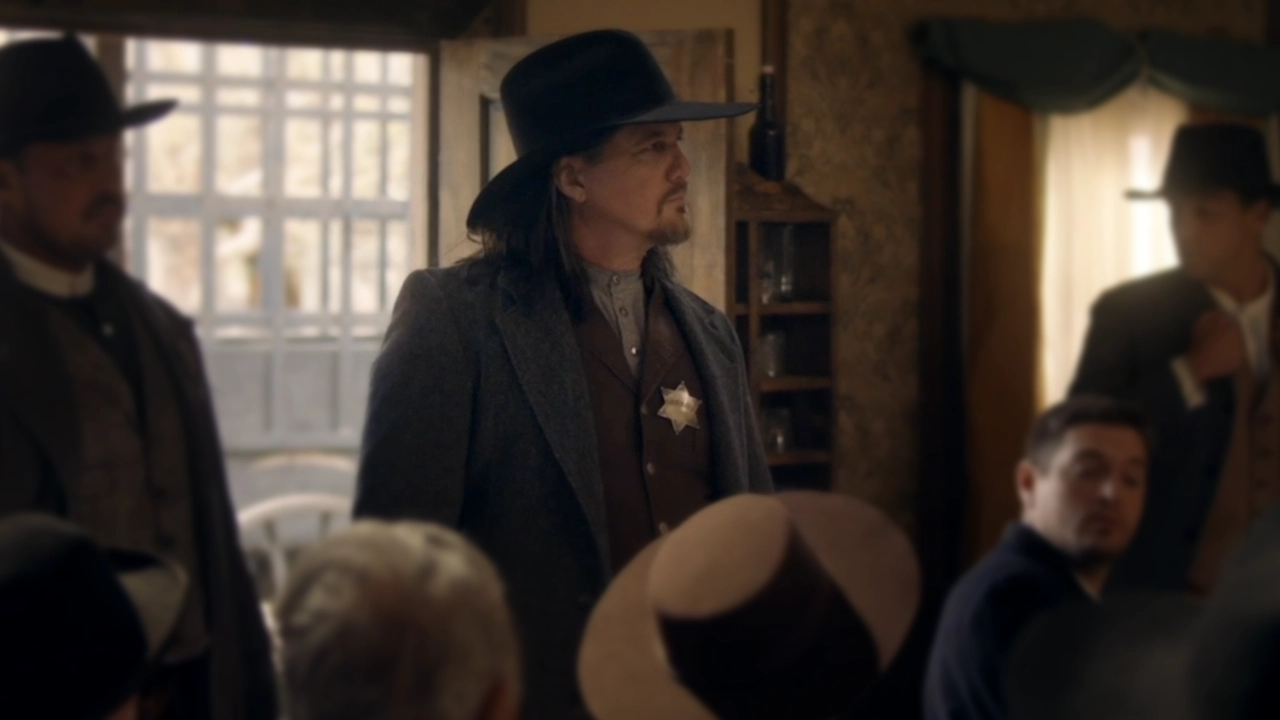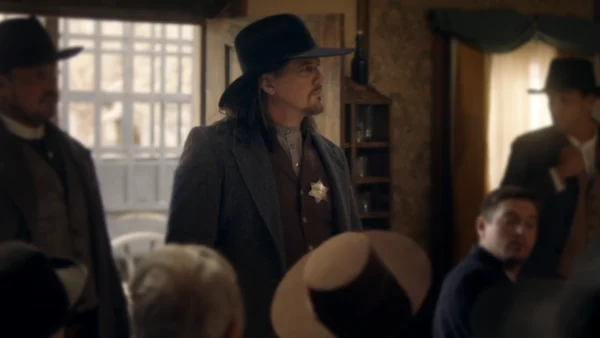
"Elkhorn" (2025)
The Badlands Get a New Law: A Look at Elkhorn and Sheriff Harmon
Elkhorn is a frontier drama set in the Dakota Badlands of the 1880s. The story follows a young Theodore Roosevelt when he is not yet President, not yet a Rough Rider, and not yet a bronzed face on Mount Rushmore. He is just a grieving 25-year-old with too much money, too much idealism, and a medically questionable desire to become a rancher in a place where winters kill cattle, gunfights settle zoning disputes, and hand lotion has not been invented.
Season 1 opens with Roosevelt arriving in the Badlands after the same-day deaths of his wife and his mother shatter his New York life. He abandons polite society and relocates to North Dakota Territory, determined to build the Elkhorn Ranch and reinvent himself in the most brutal self-help retreat in American history. He teams up with Bill Sewall and William Merrifield, hard-edged outdoorsmen who are part wilderness guides, part moral barometers, and part “please don’t get yourself killed, Teddy.” The show frames Roosevelt’s early frontier trials as the forge that creates the “Cowboy President.”
By Season 2, Roosevelt is no longer just an overeager Harvard boy with a fancy rifle. He is becoming a problem. He is taking on rustlers, land barons, hired guns, and anyone else who assumes that asthma equals weakness. The Badlands, in turn, push back. This is where Sheriff Harmon enters.
Sheriff Harmon Arrives
Season 2 of Elkhorn introduces Sheriff Harmon, played by D.C. Douglas. His badge is not decorative. Harmon is the man who tries to impose something resembling law in a region that, to this point, has largely run on ego, livestock theft, and whoever has the loudest hat. Douglas brings a dry and dangerous calm to Harmon, the sort of presence that makes an armed saloon go quiet without ever raising his voice.
Harmon’s function in the story is not comic relief. He is frontier authority with a ledger. Roosevelt has come West believing that character and grit alone will bend the world into shape. Harmon is there to remind him that the West already has a shape, and it was drawn by men with guns, deeds, and grudges. Roosevelt wants justice. Harmon wants order. The Badlands may get neither.
This creates tension Roosevelt has not faced before. Fighting a horse thief is one thing. Navigating politics in a town full of opportunists, factions, and local power structures is something else. Sheriff Harmon makes Roosevelt confront the cost of being the hero in someone else’s jurisdiction. That friction in Season 2 drives Roosevelt closer to the version of himself history remembers: a man who understands when to negotiate, when to posture, and when to threaten violence with a smile.
The Core Cast Shaping the Frontier
Theodore Roosevelt
Mason Beals plays Theodore Roosevelt. He is not portrayed as a myth yet. He is portrayed as stubborn, wounded, brilliant, and physically fragile in a world that rewards none of those traits. The show lets him earn the myth instead of inheriting it.
Marquis de Morès
Jeff DuJardin appears as the Marquis de Morès, the volatile French aristocrat who founds the town of Medora and believes banking, cattle, and casual intimidation should all blend seamlessly into one business model. The Marquis is more than a villain. He is a rival industrialist with his own empire-building vision of the West, and he considers Roosevelt both an ally of convenience and an irritating moralist with good posture.
Roosevelt’s Inner Circle
Elijha Mahar plays William Sewall, Roosevelt’s seasoned North Woods ally. Matt Wiggins plays William Merrifield, a working cowboy who views Roosevelt with equal parts loyalty and mild disbelief. Garrett Schulte appears as Wilmot Dow, and Tori Griffith appears as Rosie Maddox, grounding the ranch world with people who actually know how to keep cattle alive in a blizzard.
Medora’s Power Web
The supporting cast fills out a volatile town where everyone smiles with their mouth and negotiates with their gun hand. Sam Schweikert plays Arthur Packard. Nate Timmerman plays newspaperman E.G. Paddock. Travis Lee Eller plays Joe Ferris, a frontier businessman who has watched too many outsiders promise order and leave chaos. Cait Moira appears as Lizzie Dow, and D.C. Douglas appears as Sheriff Harmon, who would prefer not to clean up spectacular public stupidity but will, professionally, if required.
How the Series Builds Its World
Elkhorn is produced for INSP and credited to Imagicomm Entertainment. The series is positioned within INSP’s western slate, which leans into historical dramatization of frontier figures and frontier law. INSP has already built an audience for neo-classic Western storytelling that mixes historical fact and legend with clean narrative arcs, and Elkhorn fits that strategy by focusing on Roosevelt’s formative cowboy years rather than his later presidency.
Craig Miller is credited as creator and writer, and serves as producer. The production credits also include Gary Tarpinian and Paninee Theeranuntawat, names associated with docu-style historical television. The result is a hybrid tone: it looks like a drama, plays like frontier biography, and occasionally feels like a cautionary HR film about conflict escalation involving cattle, whiskey, and a printing press.
Episodes run about forty-three minutes. The series blends dusty Western gunplay, ranch logistics, and legal tension around land, branding rights, and town power structures. These are not side quests. They are how wealth, survival, and legitimacy worked in the 1880s Badlands. The show is explicit about that system and shows Roosevelt learning to play it rather than magically transcending it.
Why Sheriff Harmon Matters in Season 2
Sheriff Harmon is a structural upgrade to the show’s stakes. Until his arrival, Roosevelt mostly battles nature, grief, and individual outlaws. In Season 2 he collides with institutions. Harmon represents the codification of power in the Badlands. He is not a random gunman. He is policy with spurs.
That shift matters because Roosevelt’s long-term legacy depends on his ability to operate inside systems and then reshape them. Harmon forces Roosevelt to respect process when he would rather sprint straight to righteous action. The audience gets to watch Roosevelt test his brand of moral certainty against the real machinery of frontier law, and we get to watch Harmon decide how much of this excitable Easterner he is willing to tolerate before throwing him in a cell to cool off.
On screen, D.C. Douglas plays Harmon with practiced authority. Douglas has an extensive career in television, film, and voice acting that includes live-action drama, animation, games, and genre cult work. That range lets him switch from wry to lethal without telegraphing the transition.
Season 2: The West Starts Answering Back
Narratively, Season 2 raises the cost of every decision. Land is contested. The cattle economy is fragile. Reputations spread faster than facts. Medora is no longer just a backdrop. It is a pressure cooker. When Roosevelt helps chase down a horse thief, the arrest is not the end of the problem. It is the start of civic fallout. Allegiances shift. Locals choose sides. The Marquis de Morès bristles at any challenge to his authority. The temperature in town rises from “uncomfortable” to “please keep your hands where the Sheriff can see them.”
Sheriff Harmon stands in the middle of that powder keg and makes it clear that Medora will not eat itself without a fight. His presence signals that the era of pure, unstructured chaos is closing. The new game is politics with gun belts.
Where to Watch and Why It Matters
Elkhorn airs on INSP, a U.S. network that has leaned hard into American Western mythology and frontier-era storytelling. The network positions the series as both drama and origin myth: how grief, violence, frontier capitalism, and rough mentorship shaped a future U.S. President. It is also, bluntly, about who gets to own land, write the newspaper, run the jail, and call themselves “civilized” in a place that has not fully agreed to civilization yet.
For viewers interested in early Roosevelt, the show offers character study instead of textbook worship. For Western fans, it delivers range wars, saloon showdowns, and righteous speeches in dusty streets. For anyone who enjoys watching a confident lawman walk into a tense room and make everyone extremely polite very quickly, Sheriff Harmon makes Season 2 essential viewing.
To confirm cast, roles, and production credits for Elkhorn, including Mason Beals as Theodore Roosevelt and D.C. Douglas as Sheriff Harmon, see the official series listing on IMDb.
Final Word From the Badlands
The West in Elkhorn is not a postcard. It is a laboratory that turns grief into power, bravado into leadership, and local lawmen into the thin line between ambition and bloodshed. Season 2 makes that laboratory feel volatile and alive, and Sheriff Harmon is the man holding the lid down while Roosevelt learns how to boil without exploding.









